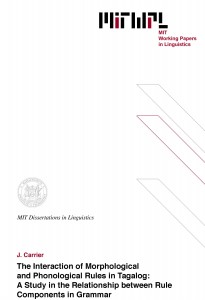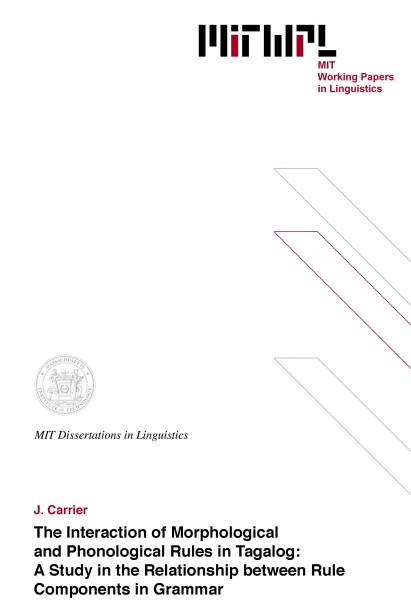The Interaction of Morphological and Phonological Rules in Tagalog: A Study in the Relationship between Rule Components in Grammar
J. Carrier, 1979
Reduplication rules in Tagalog seem to function as word formation rules (WFR’s), yet they exhibit many properties that we would like to exclude from a constrained notion of WFR. The main conclusion of this thesis is that reduplication rules belong to a subcomponent of the lexicon which until now has been unrecognized.
I argue that what was thought to be a problem with considering reduplication to be word formation is only an apparent one. It appears that reduplication rules are ordered after some phonological rules and before others. This interaction has attracted attention because it throws into question the claim that WFR’s can not be interspersed with the rules of other components. In Chapter 2, these ordering relations are illustrated and the rules involved are characterized formally. I claim on the basis of this characterization that all of the rules that precede reduplication are morphological readjustment rules (allomorphy) that apply within the lexicon. Such an argument depends on a well-defined notion of allomorphy. On the other hand, all the rules that follow can be shown to be phonological. So, if anything, the interaction of reduplication in Tagalog reaffirms the existence of a level defined by the break between the lexicon and the phonology.
However, a closer look at the reduplication rules in Chapter 3 reveals that they exhibit other properties that would make them exceptional as WFR’s:
1. They have to be formulated transformationally.
2. They add material deep inside words although general, affixation rules only add affixes to the outer edges.
3. They are oblivious in some cases to the morphological identity of the material they are copying.
4. In word formations that involve both affixation and reduplication, the reduplication has to apply after affixation. So the WFR has to be split into two sub-parts.
I propose that these exceptional properties disqualify reduplication rules from being WFR’s. Reduplication is triggered by WFR’s, but they are stated separately and are subject to their own constraints.
The formal properties of this new class of lexical rulse are investigated more closely in Chapter 5. In particular, I propose that they are triggered by abstract morphological features that are attached by WFR’s and that they do not obey the principle of subjacency. Furthermore, unlike allomorphy rules, reduplication rules apply to the output of the word formation subcomponent of the lexicon from which they are strictly separated.
In order to formulate the reduplication rules in Chapter 5, I motivate a particular morphological analysis of verbs. In doing so, I reach several conclusions, independent of my central thesis, concerning the relationship between inflectional and derivational word formation. First, the distinction between derivation and inflection is one that is observed by lexical processes – in particular, reduplication rules. Second, that there are two types of inflectional WFR’s in Tagalog. Derivational WFR’s can apply to the output of the first type. But the second type of inflection defines the final, outer layer of word formation. Finally, our analysis of Tagalog verbs leads us to the conclusion that infixes are attached by WFR’s as prefixes. They are inserted into their final resting places by an infix metathesis rule.
Thesis Supervisor: Morris Halle
Title: Ferrari P. Ward Professor of Modern Languages and Linguistics
Table of Contents
Chapter 1. Introduction. . . . . . . . . . . . . . . . . . . . . . . 11
I. The Organization of the Lexicon. . . . . . . . . . . . . . 11
II. Readjustment Rules. . . . . . . . . . . . . . . . . . . 22
IIA. Arguments for Separating Allomorphy Rules from the
Word Formation Component. . . . . . . . . . . . . 24
IIB. Arguments for Separating Allomorphy from Phonolgy. . 31
III. Issues/Conclusions in Tagalog. . . . . . . . . . . . . . . 46
Chapter 2. Interaction of Reduplication and Phonology. . . . . . . . . . 53
I. Rule Ordering. . . . . . . . . . . . . . . . . . . . . . 54
IA. Nasal Substitution. . . . . . . . . . . . . . . . . 54
IA.1. Interaction of N-Subst. with Reduplication. . . . 54
IA.2. Formal Nature of N-Subst. . . . . . . . . . . 59
IB. Vowel Syncope. . . . . . . . . . . . . . . . . . 80
IB.1. Interaction with Reduplication. . . . . . . . . 80
IB.2. The Formal Nature of Syncope. . . . . . . . . 84
IC. Morphological Length Rules. . . . . . . . . . . . . 118
IC.1. Length. . . . . . . . . . . . . . . . . . . 118
IC.2. Interaction: Reduplication and Length. . . . . . 125
ID. Rules Governing the Deletion of /?/ and /h/. . . . . . . 132
ID.1. Optional /?/-Drop. . . . . . . . . . . . . . 132
ID.2. Obligatory Deletion of /?/ and /h/. . . . . . . . 14
IE. Flapping. . . . . . . . . . . . . . . . . . . . . 18
IE.1. Interaction of Flapping and Reduplication. . . . 149
IE.2. The Formal Nature of Flapping. . . . . . . . . 152
IF. Preglide Vowel Deletion. . . . . . . . . . . . . . . 156
IG. Vowel Lowering. . . . . . . . . . . . . . . . . . 161
IH. Laxing. . . . . . . . . . . . . . . . . . . . . 165
II. How to Handle Interaction. . . . . . . . . . . . . . . . . 172
IIA. Demonstration that the Interaction Must be Handled by
Ordering. . . . . . . . . . . . . . . . . . . . . 172
Footnotes. . . . . . . . . . . . . . . . . . . . . . . . . . . 185
Chapter 3. Reduplication Rules as Readjustment Rules. . . . . . . . . . 189
I. Other Exceptional Properties of Reduplication Rules. . . . . . 189
IA. The Necessity of Formulating Reduplication Rules as
Transformations. . . . . . . . . . . . . . . . . . 189
IB. Word Internal Modification and Proper Bracketing. . . . 195
IC. Insensitivity to Morpheme Boundaries. . . . . . . . . 196
ID. Splitting WFR’s. . . . . . . . . . . . . . . . . . 199
II. Reduplication Rules as Readjustment Rules. . . . . . . . . . 202
IIA. Similarities between Reduplication Rules and Allomorphy
Rules. . . . . . . . . . . . . . . . . . . . . . 203
IIB. Why Reduplication Should be Distinguished from
Allomorphy. . . . . . . . . . . . . . . . . . . . 206
Footnotes. . . . . . . . . . . . . . . . . . . . . . . . . . 210
Chapter 4. The Morphological Structure of Verbs. . . . . . . . . . . . 211
I. The Basic Members of Verbal Paradigms. . . . . . . . . . . 212
IA. Preliminaries. . . . . . . . . . . . . . . . . . . 212
IB. Derivation vs. Inflection: The Distinction between V and
V’. . . . . . . . . . . . . . . . . . . . . . . 225
II. Verbs Derived from the Basic Members of the Paradigm. . . . 252
IIA. Inflectionally Derived Verbs: Thematic Topic Verbs. . . 254
IIB. Derivationally Derived Verbs. . . . . . . . . . . . 270
IIC. A Problem for the Inflection/Derivation Distinction. . . . 293
III. Terminal or Inflection. . . . . . . . . . . . . . . . . . . 310
IIIA. -Ang- Plural Verbs. . . . . . . . . . . . . . . . . 312
IIIB. Actual Aspect. . . . . . . . . . . . . . . . . . . 315
Footnotes. . . . . . . . . . . . . . . . . . . . . . . . . . . 323
Chapter 5. The Formal Nature of Reduplication. . . . . . . . . . . . . 327
I. The Formulation of Reduplication Rules. . . . . . . . . . . 327
IA. Cyclic vs. Word Level Assignment of [+RA]. . . . . . 333
IA.1. RA and Subjacency. . . . . . . . . . . . . . 341
IA.2. The Semantics of Aspect 2. . . . . . . . . . . 343
IA.3. Interaction of RA Reduplication and Infix
Metathesis. . . . . . . . . . . . . . . . . 346
IA.4. Other Environments for RA. . . . . . . . . . 348
IB. The Formulation of R1 Reduplication. . . . . . . . . 356
IC. The Formulation of R2 Reduplication. . . . . . . . . 359
II. The Place of Reduplication Rules in the Lexicon. . . . . . . . 362
IIA. Cyclic vs. Level Attachment of Reduplication Features. . 362
IIB. The Interaction of RA Reduplication with Allomorphy. . 366
IIC. The Interaction of Reduplication Rules. . . . . . . . 371
Footnotes. . . . . . . . . . . . . . . . . . . . . . . . . . 381

